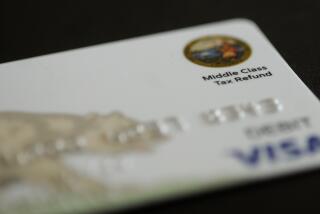Two ways to get phone tax refund
- Share via
The federal government has finally hung up the telephone excise tax on long-distance calls, and small-business owners are in line to receive a large chunk of the estimated $10 billion in refunds and interest due from the Internal Revenue Service.
To claim the refund, you have to calculate how much the 3% tax cost you for the period of Feb. 28, 2003, to Aug. 1, 2006.
You can dig through old phone bills or use a formula the IRS has created. The time spent could be well worth it, experts say. Either way, the work has to be done in time to file the claim with your 2006 income tax return.
“This is a one-time opportunity,” said David Glendenning, president of Carrier Support Group Inc., a Carlsbad, Calif.-based consulting company. “If you miss it, you’re done.”
He estimates that a company’s refund would roughly equal one month of all its long-distance charges, whether racked up on office telephones, fax machines, cellphones or Internet services.
For a company such as Diverse Staffing Inc. in Brea, that could add up quickly.
The company, which has 20 employees scattered over three locations, spent as much as $15,000 a month on voice, data and cellphone services during the three-year period, Chief Financial Officer Daniel Benninghoff said.
The Treasury Department announced in May that it would stop collecting the tax in the wake of decisions in five federal appeals courts that upheld business challenges to the tax. Phone companies were notified to stop collecting the tax on long-distance services as of Aug. 1, 2006.
The tax was established in 1898 as a luxury tax on telephone service to help fund the Spanish-American War. It has been targeted for permanent repeal almost every decade since then.
There are efforts to expand the repeal to include the federal excise tax on local phone service, as well as to extend the refund window to seven years.
For now, most companies -- those with 250 or fewer employees -- will have their refunds capped at 2% of total telephone expenses for the refund period. The cap is 1% for companies with more than 250 employees.
To help, some carriers such as AT&T; Inc., will post bills for the refund period online at no charge. Most will charge for paper copies.
A company that spends at least $2,000 monthly on long-distance calls, excluding taxes and recurring phone charges, would be best served using actual bills to calculate its refund, said Glendenning, whose company is one of several that will review old bills and calculate the refund for a fee -- his is usually 30% to 50% of the refund due.
Owners of these businesses “want to look a little deeper and make sure you capture everything,” Glendenning said.
A company with a monthly long-distance bill of less than $2,000 can use the IRS formula with less worry that it might give up a significant portion of the refund, he said. The formula uses figures from April 2006 and September 2006 phone bills.
For more information, visit www.irs.gov.
*
State sees big growth in women-owned firms
The number of California’s women-owned businesses with employees jumped by 25% in the last nine years, according to analysis by the Center for Women’s Business Research.
In 2006, women owned a majority stake in 127,840 companies with paid employees, up from 102,062 such companies in 1997, the group said. That is almost double the national growth rate in women-owned businesses of 14%, the center’s data showed.
“What you are seeing in California is very exciting,” said Sharon Hadary, executive director of the Washington-based nonprofit.
The growth has been fueled in part, she said, by women’s increased access to capital, the state’s large business and consumer markets and the robust networks of women business owners, including strong local chapters of the National Assn. of Women Business Owners.
“I travel around the country a lot and what I see in L.A. is that the audiences are larger and the organizations have a broader outreach,” Hadary said.
When companies with no employees are included, the number of privately held firms in California that are majority owned by women rises to 1.05 million, a 61% jump since 1997. The report, released last week, showed that those firms generate $152.53 billion in annual sales and employ 1.01 million people.
California ranks 14th nationwide in the growth of firms in which women held an ownership stake of 51% or more.
The center used recently released U.S. census figures for 1997 and 2002, and made its own 2006 projections. The report was paid for by the small-business unit of American Express Co.
For more information, visit www.cfwbr.org.
*
Obtain free tax help during online discussion
Get free tax advice from one of the nation’s top tax experts during a live online discussion to be held Thursday by the Small Business Administration from 10 to 11 a.m., Pacific time.
Thomas P. Ochsenschlager, vice president of taxation at the American Institute of Certified Public Accountants, will answer questions about how small-business owners can cut their 2006 tax bills.
To submit questions in advance, or to join the Web chat, go online to www.sba.gov and click on “Online Business Chat.”
*
More to Read
Sign up for Essential California
The most important California stories and recommendations in your inbox every morning.
You may occasionally receive promotional content from the Los Angeles Times.













